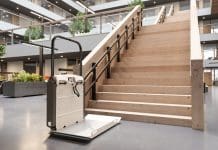On the face of it the most accessible loos would appear to be a design disaster. All that space but with all the facilities crammed into a corner?
But in terms of usability it’s perfect, and also perfectly obvious. Many disabled people need the extra space to accommodate their mobility equipment. And once seated, they need the facilities to be within reach.
A less straightforward question would be who should use an accessible loo? Some disabled people and representative groups will say a disabled loo should only be for disabled people but we would disagree.
If you can use a standard loo then ideally you should, but if an elderly couple go out with grandchildren who are too young to go to the toilet on their own which loo should they use?
What if someone is travelling alone and has luggage? Can you squeeze into a non-accessible loo at an airport or railway station with your cases?
Someone who has a hidden impairment may attract glances of disapproval for using an accessible loo but that happens already. Plenty of people whose impairment is not obvious get used to that sort of attention.
The ideal loo layout starts with the location of the room, which should be in a level area rather than somewhere accessible only by steps. It should also be free from obstructions.
We turned up at a four-star hotel on one occasion to deliver a presentation to some businesses. We weren’t there to assess the hotel but we couldn’t help giving some free advice – to move a table which was outside the loo door and would have prevented someone in a wheelchair from reaching the door handle.
Once inside, consideration needs to be given as to whether a person would prefer to move to their left or right to sit on the toilet. A peninsula toilet – one which juts out from the wall and has space on both sides – is unsafe because the user cannot get support from an adjacent wall and the loo is too far from the wash basin and paper towels.
For most users the question of right or left is purely one of personal preference, but where a building has more than one accessible loo there should be a choice of transfer directions. The transfer space should be free from obstructions, for example waste bins.
It is vital that people are able to take support from the wall and have the wash basin, soap dispenser and paper towels within reach of the pan – they have to be able to wash and dry before they get dressed.
The paper towels should be in sheet form rather than rolls, as indeed should the toilet paper. A hot air dryer is nice to have but is no replacement for a paper towel dispenser. If you install a dryer as well, make it a conventional down-draft version rather than one that people slot their hands into, which can be difficult for someone to use from a seated position or with poor manual dexterity.
The room should have good colour contrast between floor, walls and ceiling and should be fitted with a mirror which gives a reflection of the full body as far as possible, assisting users with adjusting their clothing. So it should not be placed above the wash basin, not least because that’s where the soap and paper towel dispenser should be.
Support rails are essential and should provide good colour contrast against the background. The seat of the WC pan should be secured with stainless steel fittings rather than plastic which can be easily sheared, and it should not have a lid because they can obstruct people.
The flush handle should be to the open side of the cistern, furthest from the wall, and the top of the wash basin should be in the corner nearest to the WC pan. It should be fitted with a single lever mixer tap with the water temperature regulated so it cannot scald or burn.
The emergency pull-cord should be within reach of the pan and have pull bangles at two heights, enabling operation from the floor or from a seated or standing position. The emergency re-set button should also be within reach of the pan.
Careful thought must be given to lighting, Conventional light switches present issues around height and colour contrast. If you use sensors, how sensitive are they? How long will it be before the light goes out if there is no movement? Also, a pull cord can be difficult to operate with a clenched fist, and difficult to see.
But the things that people get wrong most often are the simple things – paper towels, soap dispenser and the distance to the WC from the hand wash basin – and they are all pretty obvious once you consider how an accessible toilet may be used.
At About Access, we provide services concerned with accessibility for disabled people.
Our aim is to help organisations avoid costly and damaging conflict by ensuring that their premises are accessible. We also work to make sure staff are properly trained, and that they recognise how things can be disabling to customers and colleagues as individuals whose requirements and treatment are key to the wellbeing of a business.
Managing Director Ian Streets is a member of the National Register of Access Consultants, the Access Association and Network Rail’s Built Environment Access Panel (BEAP) and as such works with BSI Standards, the UK’s national standards body, to advise on appropriate designs for buildings and their surrounding areas.
If you want to know more, or you have a question or concern, please contact us at info@aboutaccess.co.uk













